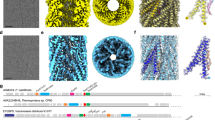Play all audios:

ABSTRACT EVERY transmissible bacterial plasmid like a colicin (_col_) factor or a drug resistance (_R_) factor necessarily contains a sex factor responsible for its transmission by
conjugation1–3. The conjugation bridge is likely to be a sex pilus4 and examination of some eighty independent plasmids of various kinds isolated from Enterobacteriaceae has shown that only
two types of sex pili can positively be identified and therefore that only two types of sex factor are probably present2,3. These are typified by _F_, the well known sex factor of
_Escherichia coli_, and by _I_, the sex factor of _colI_ (refs. 2 and 3). Phages specific for _F_-like sex pili have frequently been isolated and are of two kinds: isometric RNA phages
attaching along the length of the sex pilus and filamentous DNA phages attaching to the tip of the pilus5. The morphological and antigenic characteristics of _F_-like and _I_-like sex pili
are distinct2, so it seemed very probable, because _F_ phages do not attach to _I_-like pili, that _I_-specific phages existed. These have now been isolated2, using as hosts bacteria
carrying de-repressed (_drd_) mutants of _fi_- _R_ factors6, the sex factors of which are known to be _I_-like2. Strains carrying these mutant _R_ factors continually form sex pili and can
therefore be used as indicators for the corresponding donor-specific phages. Access through your institution Buy or subscribe This is a preview of subscription content, access via your
institution ACCESS OPTIONS Access through your institution Subscribe to this journal Receive 51 print issues and online access $199.00 per year only $3.90 per issue Learn more Buy this
article * Purchase on SpringerLink * Instant access to full article PDF Buy now Prices may be subject to local taxes which are calculated during checkout ADDITIONAL ACCESS OPTIONS: * Log in
* Learn about institutional subscriptions * Read our FAQs * Contact customer support SIMILAR CONTENT BEING VIEWED BY OTHERS ARCHAEAL DNA-IMPORT APPARATUS IS HOMOLOGOUS TO BACTERIAL
CONJUGATION MACHINERY Article Open access 07 February 2023 CONJUGATIVE TYPE IV SECRETION SYSTEMS ENABLE BACTERIAL ANTAGONISM THAT OPERATES INDEPENDENTLY OF PLASMID TRANSFER Article Open
access 25 April 2024 CRISPY-BRED AND CRISPY-BRIP: EFFICIENT BACTERIOPHAGE ENGINEERING Article Open access 24 March 2021 REFERENCES * Watanabe, T., _Fed. Proc._, 26, 23 (1967). CAS PubMed
Google Scholar * Lawn, A. M., Meynell, E., Meynell, G. G., and Datta, N., _Nature_, 216, 343 (1967). Article ADS CAS Google Scholar * Meynell, E., Meynell, G. G., and Datta, N., _Bact.
Rev._ (in the press). * Brinton, C. C., _Trans. NY Acad. Sci._, 27, 1003 (1965). Article CAS Google Scholar * Hoffmann-Berling, H., Kaerner, H. C., and Knippers, R., _Adv. Virus Res._,
12, 329 (1966). Article CAS Google Scholar * Meynell, E., and Datta, N., _Nature_, 214, 885 (1967). Article ADS CAS Google Scholar * Edwards, S., and Meynell, G. G., _J. Gen. Virol._
(in the press). * Bradley, D. E., _J. R. Microsc. Soc._, 84, 257 (1965). CAS PubMed Google Scholar * Dettori, R., and Neri, M. G., _G. Microbiol._, 13, 111 (1965). Google Scholar *
Marvin, D. A., and Hoffmann-Berling, H., _Nature_, 197, 517 (1963). Article ADS CAS Google Scholar * Hofschneider, P. H., _Z. Naturforsch._, 18b, 203 (1963). Article Google Scholar *
Marvin, D. A., _J. Molec. Biol._, 15, 8 (1966). Article CAS Google Scholar * Bradley, D. E., _Nature_, 205, 1230 (1965). Article ADS CAS Google Scholar * Mayor, H. D., and Hill, N.
O., _Virology_, 14, 264 (1961). Article CAS Google Scholar * Salivar, W. O., Tzagoloff, H., and Pratt, D., _Virology_, 24, 359 (1964). Article CAS Google Scholar * Pollard, E., and
Reaume, M., _Arch. Biochem. Biophys._, 32, 278 (1951). Article CAS Google Scholar * Hoffmann-Berling, H., and Mazé, R., _Virology_, 22, 305 (1964). Article CAS Google Scholar *
Meynell, G. G., and Lawn, A. M., _Genet. Res., Cambridge_, 10, 323 (1967). Article CAS Google Scholar * Edwards, S., and Meynell, G. G., _Microbial Genet. Bull._, No 27, 4 (1967).
Download references AUTHOR INFORMATION AUTHORS AND AFFILIATIONS * Guinness–Lister Research Unit and Department of Electron Microscopy, Lister Institute of Preventive Medicine, Chelsea Bridge
Road, London, SW1. G. G. MEYNELL & A. M. LAWN Authors * G. G. MEYNELL View author publications You can also search for this author inPubMed Google Scholar * A. M. LAWN View author
publications You can also search for this author inPubMed Google Scholar RIGHTS AND PERMISSIONS Reprints and permissions ABOUT THIS ARTICLE CITE THIS ARTICLE MEYNELL, G., LAWN, A.
Filamentous Phages specific for the _I_ Sex Factor. _Nature_ 217, 1184–1186 (1968). https://doi.org/10.1038/2171184a0 Download citation * Received: 23 January 1968 * Issue Date: 23 March
1968 * DOI: https://doi.org/10.1038/2171184a0 SHARE THIS ARTICLE Anyone you share the following link with will be able to read this content: Get shareable link Sorry, a shareable link is not
currently available for this article. Copy to clipboard Provided by the Springer Nature SharedIt content-sharing initiative
